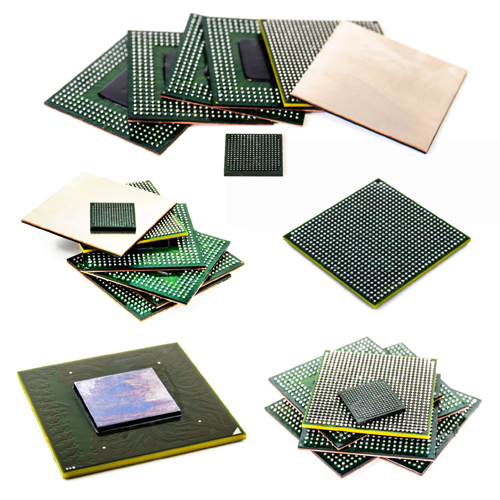Types of material available.
Circuit Board Material
The circuit board is made up of the core (substrate) and the laminate. The core is the dielectric (non-conductive) portion chosen based on dielectric constant. Laminates provide the copper foil or surface. Laminates themselves, may also be used as core material in some constructions.

Substrates
Substrates are dielectric composite structures comprised of epoxy resin and paper or glass fiber and / or ceramics to increase dielectric constant. They are formulated to meet performance property needs such as glass transition temperature (Tg).
- Tg is the temperature at which the material deforms
- Standard substrates from which the majority of PCBs are produced include:
- FR-1 thru FR-6,
- CEM-1 thru CEM-5,
- G-10 and G-11,
- Aluminum or insulated metal substrate (IMS),
- Polytetrafluoroethylene (PTFE),
- RF-35,
- Polyimide,
- Alumina
- Flexible substrates like Pyralux and Kapton
Laminates
Laminates consist of layers of cloth or paper and thermoset resin bonded under pressure. They can be produced to meet various properties. Typically, these are
- Tensile and shear strength
- Coefficient of thermal expansion (CTE)
- Tg
Dielectrics commonly used for laminates include FR-1, FR-4, polytetrafluoroethylene (Teflon), CEM-1 and CEM-3. Common pre-preg materials are FR-2 thru FR-6, CEM-1 thru CEM-5 and G-10.
The combination of substrate and laminate define the basic electrical, mechanical and thermal circuit board properties for design selection.
Circuit Board Types
Typical classification criteria includes
- component location - single-sided, double-sided, embedded
- stackup - single layer, multilayer
- design - module-based, custom, special
- flexibility - rigid, flex, rigid-flex
- strength – mechanical or electircal
- functionality - high frequency, high power, high density, microwave
- High Frequency (High Speed) - 500MHz - 2GHz range.
- High Power (High Current) - wider traces, thicker copper, temperature rating
- High Density (High Density Interconnect) - thin traces, laser microvias and thin high-performance materials.
- Microwave - signal speeds from 1GHz to hundreds of GHz